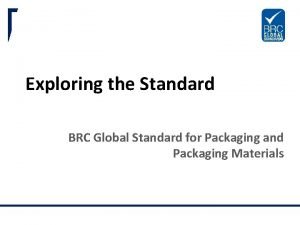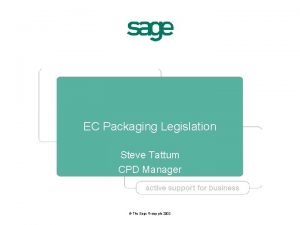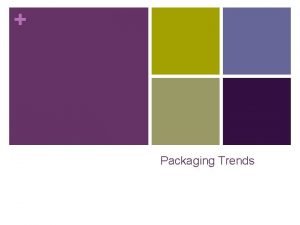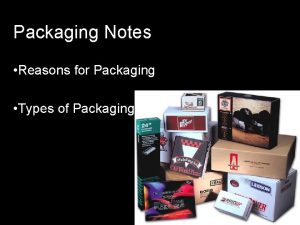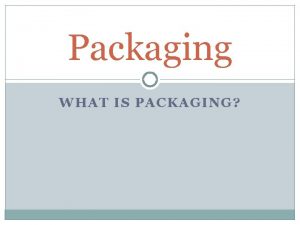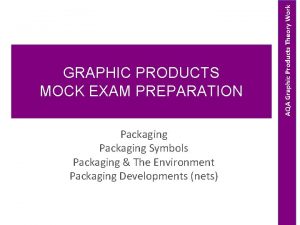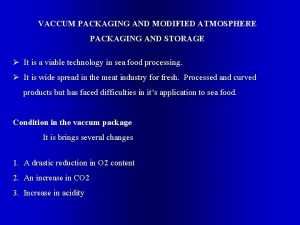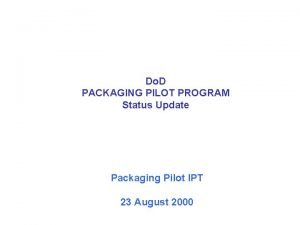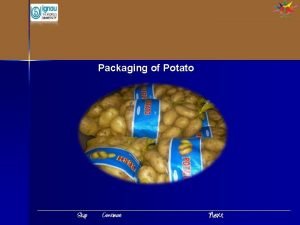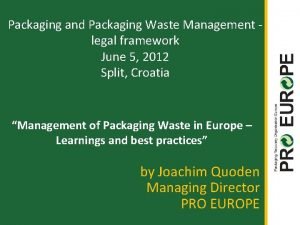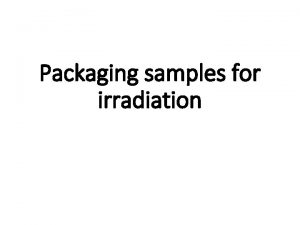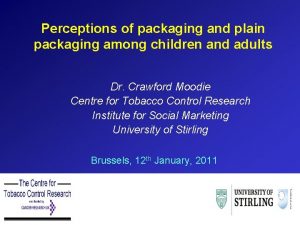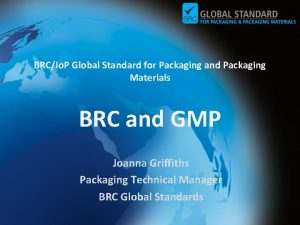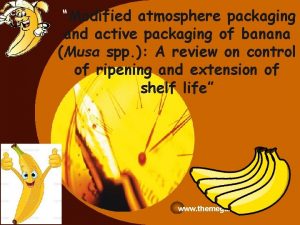We do not make the Packaging We make


























- Slides: 26


We do not make the Packaging, We make it Insect Resistant Corrugate Flexible Films Cartons Paper Bags Super Sacks

Packaging and Consumer Studies Concerning Insect Resistant Packaging Market Demands and Drivers on packaging Pest control trends Commercial bag study testing against insect resistance Consumer Perceptions Commercially Available Product and Uses

We Solve an Ancient Problem Indianmeal Moth Plodia interpunctella (Hubner) "One female, in less than two months, can produce 6, 750, 000 larvae. At 1/2 inch per larvae, that translates to 53 miles of larvae. Imagine their food consumption if all survive!“ Mike Mullen- USDA Entomologist Provision. Gard controls all stored grain insects

Insect Resistant Packaging Drivers Food Brands Largest consumer comment for Rice, Pasta, Flour, and Pet. Food Manufacturing/Distribution Millions are spent annually protecting the supply chain from insects Fumigations of entire plant facilities, ongoing pesticide treatments Global supply pressure on packaging and quality Ecological Impact Fumigants destroy the ozone layer and contribute to Global Warming Humanitarian Impact Food for Peace Programs lose 10 -20% of Food aid to insect damage

Customer Value Equation: Grain Based Retail Product IRP Improves Company X’s Profitability by $700 M.

Commercial Bag Design Assessment • • Experimental Assessment of Resistance of Three Designs - Standard MW Paper Bag- Pinch - Laminated PE to Paper Bag-Pinch - Woven Poly SOM • Chambered with 2000 IMM for 90 days

Insects Either Invade or Chew Their Way Into a Package larvae

Average number of IMM found within each bag type. Summary Data Ave No. IMM/Bag % Bags Infested Standard Multi-Wall (MW) 30 2 Rev Print Multi-Wall (RPP) 80 4 Woven-Poly Rev Print (WPP) 90 12

Technologies to Improve Insect Resistance • What are your choices……

Packaging Insect Control Technologies 3 Best Safety Attribute (Toxicity, Green, EPA) Provision. Gard safely delivers long-term infestation protection. 1. 5 Provision. Gard Failed due to adverse effect on food taste. Repell. Kote Bug. Ban 9000 0 Poo r 0 Methyl Bromide Failed due to toxicity 1. 5 Performance Attribute (Efficacy; Scope, Duration) EPA wants to phaseout; Negatively impacts ozone 3

Summary Chart of Average Number Insects Observed by Species Between Treated and Control Bags- SOM Paper Multiwall Comparison of Provision. Gard coated and Untreated Control Bags 700. 00 648. 80 600. 00 AVE Insects Observed 500. 00 465. 51 443. 42 496. 04 400. 00 Red Flour Beetle 300. 00 Sawtooth Grain Beetle Indian meal moth 200. 00 100. 00 6. 62 7. 93 7. 40 18. 00 0. 00 Provision. Gard Whole Wheat Flour Provision. Gard Malted Untreated Control Whole Untreated Control Malted Barley Wheat Flour Barley Bags Tested

Evaluation of Provision. Gard for Control of Flour Beetles Packaging- Woven Poly Bag Dr. Frank Arthur Research Entomologist USDA-ARS-CGAHR Manhattan, KS 66502

Methods-Test 1 • Circular disks of packaging cut to fit bottom portion of a 9. 6 in 2 plastic Petri dish • Disks with inner and outer portions of the packaging • Ten 4 -week old red flour beetle larvae or ten confused flour beetle larvae of same age put in separate dishes with 300 mg flour Treated Dish-left, Untreated-right

USDA 12 Month Efficacy Results % Emergence-Red Flour Beetle Inside Layer Conclusions of Year Long Study Outer Layer Month 0 5. 0 ± 2. 0 0. 0 ± 0. 0 Month 2 3. 3 ± 2. 1 1. 6 ± 1. 6 Month 4 23. 3 ± 3. 3 5. 0 ± 3. 4 For the RED FLOUR BEETLE, the inside layer of the bag loses over 50% of the efficacy after 6 months and there is significant variation between the months. Month 6? 66. 7 ± 21. 1 ± 3. 3 6. 7 Month 8 30. 0 ± 12. 1 ± 0. 0 Month 10 13. 3 ± 4. 9 0. 0 ± 0. 0 Month 12 1. 7 ± 1. 7 70. 0 ± 5. 8 The Outer layer of the bag material controls consistently over the 12 month period having 90%+ efficacy with RED Fl. OUR BEETLES

Rice Packaged in Treated Cartons and Treated Corrugate Boxes Indian Meal Moth CBR Cartons (18 cartons/shipper) Control Brown Rice Cartons (18 cartons/shipper) Treated Control Total # of shippers 14 10 Total # of insects 329 Average # insects/shipper Range of insect count/shipper Total # of shippers 8 11 0 Total # of insects 60 5 23. 5 0. 0 Average # insects/shipper 7. 5 0 – 132 0 – 0 0 – 37 0– 3 Range of insect count/shipper Average reduction in treated vs. control Treated Average reduction in treated vs. control 100% efficacy CBR Poly (6 bags/shipper) In Corrugate Boxes Control Whole Grain 5# Poly (12 bags/shipper)in Corrugate Box Control Treated Total # of Shippers 28 28 Total # of Insects 182 3 Total # of Shippers Total # of Insects Average # of insects/shipper Range of insect count/shipper 6. 5 2 – 13 Average Reduction in Treated vs. Control 0. 1 0– 1 99% efficacy 93. 4% efficacy Treated 10 15 95 0 9. 5 0 1– 23 0– 0 Range of insect count/shipper Average Reduction in Treated vs. Control 100% efficacy

“Blinded” Pet Food: Multiwall Bags

Consumer Perception Study Vivian Wang | Amanda Stewart | Kerry Chuanyuan

Consumer Perception on Product if Insects/ Foreign Matter Contaminated Packaged Foods 86% 2. 98% 25. 89% 61. 01% 2. 68% 7. 44% Key Takeaway: Over 86% of consumers would be uncomfortable with the PRODUCT moving forward, and it would influence their future purchase. Findings & Hypotheses Implications 19

Consumer Perception on Food Category if Insect/ Foreign Matter Contaminated Packaged Foods 53% Key Takeaway: 53%+ consumers would be uncomfortable with the FOOD CATEGORY moving forward, and it would influence future purchase. Findings & Hypotheses Implications 20

Provision. Gard™ The Science Food packaging coating that eliminates insect infestations IGR (Insect Growth Regulator) X X Pupa Adult X X Chemical Toxicity (LD 50) Water 90000 mg/kg Methoprene 34000 mg/kg Vitamin C 11000 mg/kg Table Salt 3000 mg/Kg Caffeine 192 mg/kg EPA Methoprene Tolerance 40 CFR § 180. 1033 Methoprene is exempt from a tolerance in and on all Food commodities when used to control insect larvae.

Provision. Gard™ Commercially Available Products PGT IGR 30000 EPA Labeled Additive for use on Food, Feed and Tobacco Packaging EPA Registration Number 81390 -2 Adhesives IGR 30000 Coatings Solvent/Solventless Additive PGT 24000 water- based paper coating PGT 23207 waterbased carton coating Polymer Films PGT 81086 PE Additive Pellets

Provision. Gard™ Commercially Available Products Press Ready Water-base Coating Film Extrusion Ready PE Pellets Extruded into Film Packaging Applied to Paper Packaging Multiwall Bags Cartons- Cereal, Mixes etc. Corrugate Boxes Bulk Shipping Containers Paper Canisters-Flour/oatmeal Woven Poly Bags Blown film Stretch film Shrink overwrap films Super Sacks Passes odor and taste testing IGR 30000 Additive Mixed into Adhesives Form and fill plastic bags Stand up PET Pouches Two Play Film Bags

Provision. Gard™ Commercially Available Products Press Ready Water-base Coating Applied to Paper Packaging l. PGT 23207 – Carton coating Film Extrusion Ready PE Pellets Extruded into Film Packaging IGR 30000 Additive Mixed into Adhesives PGT IGR 30000 Liquid Additive PGT 24000 - Kraft paper coating PGT IGR 81086 Polymer Pellet Additive Clear water based topcoat Food Grade PE Pellet Liquid Additive • Combines and resides in films • Manually combines with Pellets • Delivered in Pellet form • Can be Blown or added to Extruder • No Odor or Taste • Non Toxic and Non Hazardous • Added at. 5% - 2% • Combines and resides in adhesive • Mix in preformulated formulas • Solvent compatible • Solventless compatible • No Odor or Taste • Non Toxic and Non Hazardous • Added at. 5% - 2% • Bonds not affected · Printed over graphic images or inner liner of bag · Replaces existing coatings · PGT 23207 duplicates existing coating in COF Gloss Rub Resistance ·. 5 -. 6 lbs per ream coating weight

Provision. Gard Regulatory Status EPA Regulates the use of IGR’s in Food Packaging Provision. Gard™ is registered with the EPA (registration # 81390 -2) Under regulation 40 CFR § 180. 1033, the EPA has established that “methoprene is exempt from the requirement of a tolerance in or on all food commodities when used to control insect larvae. ” FDA Status FDA Provides Monitoring role which ensures Maximum Residual Limits are not exceeded. The tolerance and tolerance exemption regulations under 40 CFR § 180 are directly related to FDA regulation 21 CFR § 170. 19. The FDA has determined that residues of any pesticide found in food are acceptable so long as the amounts in the food are at or below the tolerance amounts established by the EPA under 40 CFR § 180.

Questions
 Brc global standards directory
Brc global standards directory Steve tattum
Steve tattum Uncontrolled, lacking in restraint
Uncontrolled, lacking in restraint Hát kết hợp bộ gõ cơ thể
Hát kết hợp bộ gõ cơ thể Lp html
Lp html Bổ thể
Bổ thể Tỉ lệ cơ thể trẻ em
Tỉ lệ cơ thể trẻ em Gấu đi như thế nào
Gấu đi như thế nào Tư thế worm breton
Tư thế worm breton Chúa sống lại
Chúa sống lại Các môn thể thao bắt đầu bằng từ đua
Các môn thể thao bắt đầu bằng từ đua Thế nào là hệ số cao nhất
Thế nào là hệ số cao nhất Các châu lục và đại dương trên thế giới
Các châu lục và đại dương trên thế giới Cong thức tính động năng
Cong thức tính động năng Trời xanh đây là của chúng ta thể thơ
Trời xanh đây là của chúng ta thể thơ Cách giải mật thư tọa độ
Cách giải mật thư tọa độ Phép trừ bù
Phép trừ bù Phản ứng thế ankan
Phản ứng thế ankan Các châu lục và đại dương trên thế giới
Các châu lục và đại dương trên thế giới Thơ thất ngôn tứ tuyệt đường luật
Thơ thất ngôn tứ tuyệt đường luật Quá trình desamine hóa có thể tạo ra
Quá trình desamine hóa có thể tạo ra Một số thể thơ truyền thống
Một số thể thơ truyền thống Bàn tay mà dây bẩn
Bàn tay mà dây bẩn Vẽ hình chiếu vuông góc của vật thể sau
Vẽ hình chiếu vuông góc của vật thể sau Thế nào là sự mỏi cơ
Thế nào là sự mỏi cơ đặc điểm cơ thể của người tối cổ
đặc điểm cơ thể của người tối cổ V cc cc
V cc cc
